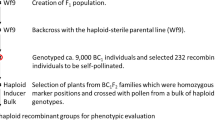Abstract.
Univalent chromosomes at meiotic metaphase I have a tendency to misdivide at the centromeres. Fusion of the misdivision products may produce Robertsonian translocations. The fine structure of the centromeres in Robertsonian wheat-rye translocation chromosomes was analyzed by fluorescence in situ hybridization (FISH) using two centromere-specific DNA clones: pRCS1, derived from rice, and pAWRC1, derived from rye. Clone pRCS1 hybridizes to the centromeres of all grasses including wheat and rye, whereas clone pAWRC1 is rye specific and hybridizes only to the centromeres of rye. Four of the six wheat-rye translocations derived from a single centric misdivision event (1st generation translocations) had hybrid centromeres, with approximately half of the centromere derived from rye and half from wheat. In the two other 1st generation translocations, the entire centromere was derived from rye. Among eight reconstructed wheat and rye chromosomes that originated from two consecutive centric misdivision-fusion events (2nd generation translocations), T1BS·1BL (derived from T1BS·1RL and T1RS·1BL) and one of three T2BS·2BL (derived from T2RS·2BL and T2BS·2RL) had hybrid centromeres. T1RS·1RL (derived from T1BS·1RL and T1RS·1BL), two of three T2BS·2BL, and all three T2RS·2RL (derived from T2RS·2BL and T2BS·2RL) had rye centromeres. All three 3rd generation translocations had hybrid centromeres with approximately half of the centromere derived from rye. There were no indications that the composite structure of the centromere in these chromosomes affected their behavior in mitosis or meiosis. These observations support the notion of a compound structure of the centromere in higher organisms, and indicate that during the centric breakage-fusion event, centromere breakage may occur in different positions along the segment of the chromosome that interacts with the spindle fibers. Normal behavior of the 1st, 2nd, and 3rd generation centric translocations in mitosis and meiosis indicates that, at least in wheat and rye, centromeres are not chromosome specific.
Similar content being viewed by others
Author information
Authors and Affiliations
Additional information
In revised form: 22 May 2001
Electronic Publication
Rights and permissions
About this article
Cite this article
Zhang, P., Friebe, B., Lukaszewski, A.J. et al. The centromere structure in Robertsonian wheat-rye translocation chromosomes indicates that centric breakage-fusion can occur at different positions within the primary constriction. Chromosoma 110, 335–344 (2001). https://doi.org/10.1007/s004120100159
Received:
Accepted:
Issue Date:
DOI: https://doi.org/10.1007/s004120100159




